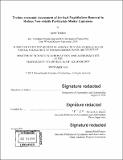| dc.contributor.advisor | Steven R.H. Barrett. | en_US |
| dc.contributor.author | Weibel, Drew(Drew E.) | en_US |
| dc.contributor.other | Massachusetts Institute of Technology. Department of Aeronautics and Astronautics. | en_US |
| dc.date.accessioned | 2020-03-23T18:09:50Z | |
| dc.date.available | 2020-03-23T18:09:50Z | |
| dc.date.copyright | 2018 | en_US |
| dc.date.issued | 2018 | en_US |
| dc.identifier.uri | https://hdl.handle.net/1721.1/124174 | |
| dc.description | Thesis: S.M., Massachusetts Institute of Technology, Department of Aeronautics and Astronautics, 2018 | en_US |
| dc.description | Cataloged from PDF version of thesis. | en_US |
| dc.description | Includes bibliographical references (pages 57-61). | en_US |
| dc.description.abstract | Naphthalenes have been identified as a precursor to aviation-attributable black carbon (BC) emissions. Given its 1-2 vol% concentration in jet fuel, there are several refining processes that may be used to remove naphthalene without impacting its ability to meet specification. This study evaluates the economic feasibility of jet fuel naphthalene removal (via hydro-treatment or extractive distillation). We develop a stochastic discounted cash flow model based on the retrofit of existing US refineries with naphthalene removal systems, and compute costs from both societal and market perspectives. We find that the US-average cost premium over the market price of jet fuel is 4.7 cents/liter for hydro-treatment and 3.1 cents/liter for extractive distillation. Considered from a societal perspective, costs are 1.7 cents/liter and 2.4 cents/liter, respectively. The costs incurred by small refineries can be up to 270% higher than the national average. Hydro-treatment costs are found to be more sensitive to upfront capital investment, while extractive distillation costs are more sensitive to crude price volatility. Additional jet fuel life cycle greenhouse gas emissions from naphthalene removal are 3.35gCO₂e/MJ and 3.12gCO₂e/MJ for hydro-treatment and extractive distillation, respectively. Coupled with analysis of the impacts of reduced aviation-attributable BC emissions, this work can provide a comprehensive comparison to alternative emission reduction pathways. | en_US |
| dc.description.statementofresponsibility | by Drew Weibel. | en_US |
| dc.format.extent | 61 pages | en_US |
| dc.language.iso | eng | en_US |
| dc.publisher | Massachusetts Institute of Technology | en_US |
| dc.rights | MIT theses are protected by copyright. They may be viewed, downloaded, or printed from this source but further reproduction or distribution in any format is prohibited without written permission. | en_US |
| dc.rights.uri | http://dspace.mit.edu/handle/1721.1/7582 | en_US |
| dc.subject | Aeronautics and Astronautics. | en_US |
| dc.title | Techno-economic assessment of jet fuel naphthalene removal to reduce non-volatile particulate matter emissions | en_US |
| dc.type | Thesis | en_US |
| dc.description.degree | S.M. | en_US |
| dc.contributor.department | Massachusetts Institute of Technology. Department of Aeronautics and Astronautics | en_US |
| dc.identifier.oclc | 1143740791 | en_US |
| dc.description.collection | S.M. Massachusetts Institute of Technology, Department of Aeronautics and Astronautics | en_US |
| dspace.imported | 2020-03-23T18:09:48Z | en_US |
| mit.thesis.degree | Master | en_US |
| mit.thesis.department | Aero | en_US |
